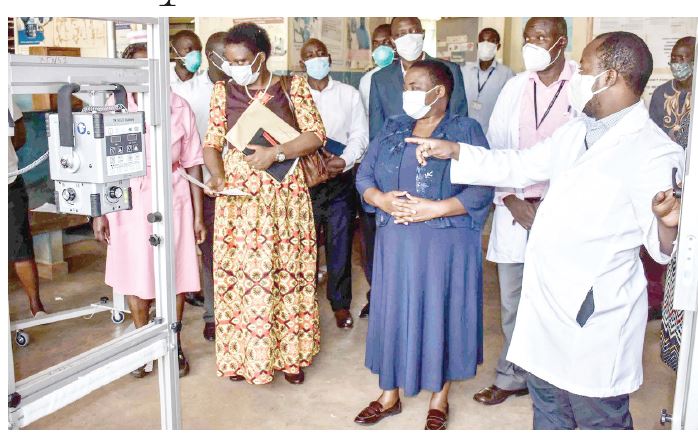Prime
Kalisizo Hospital without X-ray services since 2016

Prime Minister Robinah Nabbanja (centre) commissions an X-ray machine at Kamuli General Hospital in May. FILE/PHOTO
What you need to know:
- An X-ray is performed to diagnose diseases and check how well a prescribed treatment is working
Health workers at Kalisizo Hospital in Kyotera District have expressed concern over the delayed replacement of an X-ray machine, which broke down five years ago.
The X-ray machine broke down in 2016, eight years after the Ministry of Health donated it to the hospital.
Dr Emmanuel Ssekyeru, the hospital medical superintendent, said their efforts to have the machine repaired have yielded no fruits.
“It’s true we are having the challenge of offering X-ray services ever since the machine got a problem,” Dr Ssekyeru said.
“Some of the procedures can no longer be performed here. We are forced to refer the patients to Masaka Regional Referral Hospital or ask them to seek services from other neighbouring private clinics,” he said yesterday.
Located on the Masaka-Kyotera –Mutukula highway, the hospital receives more than 100 accident victims a month with 20 of them in critical condition, according to Dr Ssekyeru. He said X-ray services are so much needed during the current Covid-19 period since patients want to know whether their lungs are still in good health or damaged.
“We have oft en written letters to the responsible authorities to give us a new X-ray machine, but we are yet to get a response,” he explained.
Dr Ssekyeru said orthopeadic specialists can hardly treat accident victims without X-ray results because it’s the best way one can tell the position of the bones.
“An X-ray is a very essential medical tool as far as treating patients is concerned. A doctor can easily detect intestinal obstruction; take photos in the brain, chest and bones also. Patients with pneumonia, accident victims as well as those with heart problems also need X-ray,” he said.
A modern X-ray goes for up to Shs200m, according to Dr Ssekyeru. Dr Edward Muwanga, the district health offi cer, said the absence of an X-ray service has made staff in the radiology department redundant.
“It is unfortunate that a hospital such as Kalisizo, which is in a border district, has spent all those years without such a machine,” he said.
Dr Muwanga urged government to prioritise the installation of a new X-ray machine at the hospital because it handles many cases, including those from neighbouring Tanzania.
“Our hospital should be given priority, especially during this Covid-19 period where we attend to diff erent people from Tanzania and the neighbouring districts of Lwengo, Masaka, and Rakai,” he added.
The Ministry of Health spokesperson, Mr Emmanuel Ainebyoona, did not answer our repeated calls by press time.
Kalisizo General Hospital began way back in 1926 as a centre for vaccinating people against small pox.
In 1932, mud-and-wattle structures with grass thatched roofs were built after the family of Rev Father Boniface Mubiru donated the land to the government.
Permanent buildings were later built by the colonial government and the unit operated as a dispensary until 1988 when the central government elevated it to a general hospital. Today, the facility has 110 beds, serving an estimated one million people in the districts of Kyotera, Lwengo and Rakai.
WHAT IS AN X-RAY?
Purpose. An X-ray is a common imaging test that’s been used for decades. It can help your doctor view the inside of your body without having to make an incision. This can help them diagnose, monitor, and treat many medical conditions.
Different types of X-rays are used for different purposes. For example, your doctor may order a mammogram to examine your breasts. Or they may order an X-ray to get a closer look at your intestinal tract.


